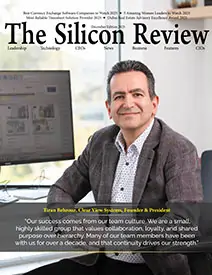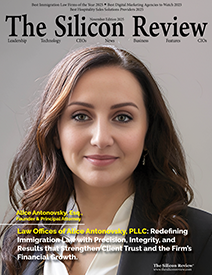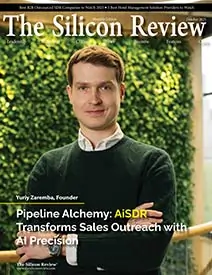50 Most Admired Companies of the Year 2021
Anticancer Bioscience: A Precision Therapeutics Company Dedicated to Discovering and Developing Breakthrough Cancer Therapies for Unmet Oncology Needs Around the World
The Silicon Review
![]()
“Equipped with entirely novel, proprietarily synthetic, and natural product small molecule libraries, the biotech company has discovered anticancer compounds with innovative mechanisms of action that exploit the genetic and epigenetic vulnerabilities of cancers, especially with MYC overexpression.”
Anticancer Bioscience (ACB) is a precision therapeutics company specializing in synthetic lethal approaches to develop targeted cancer therapies. As a global biotech, ACB has its R&D and operational headquarters in Tianfu International BioTown, Chengdu, China. With the latest addition of the AI team in Sydney, ACB now coordinates teams at four other sites in India, Australia, the UK, and the US, enabling it to access global experts in fields such as medicinal chemistry, machine learning, bioinformatics and clinical trial management, as well as global business development.
The Story Behind Anticancer Bioscience
After the completion of his PhD in biochemistry at Columbia University, New York, in 2000, the company’s CEO and founder, Dr. Dun Yang, moved to California to pursue postdoctoral training at the University of California, San Francisco, under the mentorship of Nobel Laureate, Dr. J. Michael Bishop.
After working closely with Dr. Bishop in the field of cancer biology for over 16 years, Dr. Yang returned to his hometown in China to establish the J. Michael Bishop Institute of Cancer Research with the aim to discover new knowledge and conduct high-risk high-impact projects in basic research. Dr. Yang, together with Drs Jing Zhang and Shenqiu Zhang from the UK, co-founded Anticancer Bioscience (ACB) as the commercialization organization of the Institute in 2016. Two of Dr. Yang’s former colleagues in the J. Michael Bishop’s research group, Drs. Thaddeus Allen and Hong Liu, subsequently joined ACB because of their shared interest in developing innovative oncology drugs to meet unmet medical needs. By taking an unconventional approach to exploiting novel ideas for drug discovery from natural products, Dr. Yang and his team are committed to transforming breakthroughs discovered at the Institute into innovative cancer therapeutics.
Since ACB specializes in developing synthetic lethal cancer therapies, it was important for the company to look for compounds that were non-toxic to normal cells but would manifest potent cytotoxicity to cancer cells. Most medicinally used natural products are known to have low toxicity and, therefore, meet this need. More importantly, the natural compounds found in plants can contain structural diversity that is unmatched by synthetic compound libraries. ACB is strategically located in Chengdu, the capital of Sichuan province, which accounts for over 60% of plant diversity in the country. This location positions ACB in proximity to a diverse source of natural products that will continuously and sustainably provide lead compounds for its drug development pipeline. In addition, ACB has developed lead-like synthetic compound libraries. In combination, these two types of libraries enable screening across a diverse repertoire of medicinal plants and a broad drug-like chemical space.
Fighting Cancer with an Iron Fist
ACB’s expertise in synthetic lethal approaches to precision oncology, combined with its deep knowledge of MYC biology and cell division, has allowed the company to build a broad pipeline. Rather than focusing on a single asset or biological mechanism, ACB has established five innovative and biomarker-driven R&D programs. Each program is designed to deliver first-in-class drugs that interfere with previously unexplored targets and could treat a large variety of cancers. In addition, the drug candidates from each of the five programs act through distinct mechanisms and have the potential to be used in combination with each other or with clinically approved therapies to treat cancer.
The most advanced program in the pipeline is the MYC-SL program, which focuses on targeting cells with overexpression of the MYC oncogene. The deregulated expression of the MYC oncogene represents one of the most frequent anomalies in human malignancies and correlates with poorly differentiated, very aggressive, and difficult-to-treat cancers. Although MYC is generally considered an important and broadly applicable oncology target, no direct inhibitors of MYC are approved. Furthermore, direct inhibition of MYC may yield undesirable side-effects as MYC plays a vital role in many important cellular processes. An alternative approach is to exploit a synthetic lethal interaction between MYC overexpression and a therapeutic effect. ACB is taking the synthetic lethal approach that allows the selective killing of tumor cells with overexpression of MYC while sparing normal cells. ACB has developed five classes of compounds and accomplished lead optimization for two of the five classes, and expects to progress at least one compound into the clinic in 2022. The target in this program has not been explored with any other synthetic lethal cancer therapies to date.
![]()
In parallel to the MYC-SL program advancing toward human testing, a second program in the pipeline, the contact inhibition restoration (CIR) of proliferation program, focuses on restoring the cell-cell and cell-matrix controlled contact inhibition of cell division, which is lost in malignancy. As an innovative therapeutic approach, ACB’s CIR program is distinct in the outcome that it attempts to induce in tumors. This therapy aims not to kill cancer cells per se, but instead, to reverse a key hallmark of cancer: the loss of contact inhibition of proliferation. ACB has established an image-based high-throughput screening platform to identify agents that can enable cancer cells to re-establish contact inhibition of proliferation. After completing a pilot screening, ACB has identified two such drugs and compounds that synergistically enhance CIR activity. These combination treatments suppressed the formation of tumor cell spheroids in soft agar assays, but the greater test came when ACB moved into preclinical murine models, where cells grow as a mass rather than in a single layer. The program has further generated in vivo evidence of efficacy in animal models, and ACB aims to take this program into the clinic.
In addition to synthetic lethal interactions with the MYC oncogene, ACB is also working on other synthetic lethal interactions. In a tumor suppressor gene (TSG)-SL program, ACB aims to identify drugs that are synthetically lethal with loss of tumor suppressors like TP53. In the polyploid-SL program, ACB aims to identify compounds that target vulnerabilities unique to polyploid cells as opposed to their diploid counterparts. A fifth program focuses on supernumerary centrosomes, a relatively unexplored vulnerability of cancer cells. ACB has identified hit compounds for all of these programs and is making progress on lead optimization.
Fueling the Pipeline with Novel and Proprietary Compound Libraries
As mentioned above, to provide sources of lead compounds that can fuel its drug development pipelines, ACB is utilizing two types of compound libraries: natural product libraries and drug-like synthetic compound libraries.
Natural products remain an excellent source for the discovery of drug leads due to their extensive diversity, broad chemical space, and complex chemotypes unavailable to synthetic combinatory libraries. To unlock the medicinal promise of natural products, ACB is building reliable and trackable pre-fraction libraries suitable for high-throughput and high-content screening, and is developing complementary innovative screening assays. These natural product libraries are mainly derived from Traditional Chinese Medicinal herbs that comprehensively cover plants used to treat cancer long before the advent of modern medicine. The natural product libraries at ACB are composed of more than 17,500 crude extracts, over 1,200 partially purified fractions, and around 2,500 pure natural compounds from over 2,600 plants, representing more than 1,500 plant species used in Traditional Chinese Medicine. ACB has discovered and identified a variety of bioactivities from these natural product libraries, validating their generally applicable utility. ACB plans to expand these libraries to cover more diversified plant species with the belief that the libraries can play an important role in the discovery of not only cancer drugs but also drugs that treat other diseases. Moreover, to ensure the availability and reproducibility of raw materials, ACB is building its own plant diversity gardens and is expanding a network of collaborating partners to gain access to medicinal herbs cultured at a large scale. In addition, ACB is partnering with various national reserves to study and preserve rare plants and plants in danger of extinction.
Alongside the natural product libraries, ACB takes a unique approach to generate lead compounds from constructing synthetic mini-libraries and expanding these libraries on demand during the lead optimization process. These libraries are called ‘general utility new scaffold-drug fragment’ libraries, with the acronym “GUNS-DF”. These mini-libraries are constructed using principles of medicinal chemistry that anticipate potent inhibitors with enhanced drug-like properties. One key feature of the GUNS-DF libraries is a patentable lead-like core scaffold that permits size expansion and diversity augmentation during lead optimization. Since activating mutations in kinases can initiate tumorigenesis and drive the progression to metastasis, the kinome represents the most promising class of oncology targets. ACB has designed ten distinct GUNS-DF pilot libraries, most of which are created with kinase inhibitory activity in mind. Through the screening of these libraries, ACB has identified multiple potent compounds for the MYC-SL and TSG-SL programs, illustrating the utility of their approach. More importantly, the screening process has already produced preliminary structure-activity relationship data, therefore significantly shortening the time required for the lead optimization. To further accelerate lead optimization, ACB incorporates machine learning techniques to the R&D process. The AI team uses three-track neural networks such as AlphaFold and RoseTTAFold to predict protein structures and protein-small molecule interactions, generating additional data to guide the lead optimization and prediction of drug responses and rational drug combinations.
Moving into clinical development
ACB is on a mission to deliver first-in-class oncology drugs against unexplored and previously undruggable targets. The goal is to improve outcomes in patients with poorly differentiated and aggressive cancers, thereby realizing the therapeutic potential of Yang’s vision and Bishop’s heritage.
_2025-12-15_12-44-58.webp)


_2025-11-17_06-38-14.webp)

 (1)_2025-10-21_13-35-14.webp)
